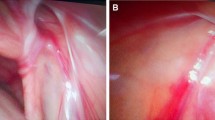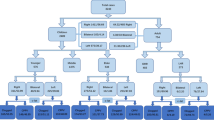Abstract
Purpose
Many trials have been done to make sure probability of metachronous contralateral side hernia (MCH) and contralateral patent processus vaginalis (CPPV). But the necessity of contralateral side exploration is still on debate. The aim is to investigate the risk factors for the consideration of contralateral examination on operation.
Materials and methods
The study was designed as retrospectively. Patients with unilateral inguinal hernia from January 2010 to May 2015 were enrolled. Pre-operative ultrasonography was done in all patients. Patients with obvious contralateral side hernia on pre-operative US were excluded. The presence of CPPV was evaluated by transinguinal laparoscopy during the operation.
Results
In univariate analysis, hernial sac size only shows difference (P value: 0.001). The others, location of the hernia, age at surgery, gestational age (preterm), low birth weight and parent’s age, did not show statistically significant differences. Multivariate analysis also demonstrates CPPV is more common in patients with large hernial sac (Odds ratio: 2.727, 95% confidence interval 1.495–4.974, P value: 0.001).
Conclusion
We propose that surgeons should consider contralateral evaluation during operation in case with large ipsilateral hernial sac, although CPPV was not detected by pre-operative US.

Similar content being viewed by others
References
Mollen KP, Kane TD (2007) Inguinal hernia: what we have learned from laparoscopic evaluation of the contralateral side. Curr Opin Pediatr 19(3):344–348
Miltenburg DM et al (1997) Meta-analysis of the risk of metachronous hernia in infants and children. Am J Surg 174(6):741–744
Miltenburg DM et al (1998) Laparoscopic evaluation of the pediatric inguinal hernia–a meta-analysis. J Pediatr Surg 33(6):874–879
Rothenberg RE, Barnett T (1955) Bilateral herniotomy in infants and children. Surgery 37(6):947–950
Kokorowski PJ et al (2014) Evaluation of the contralateral inguinal ring in clinically unilateral inguinal hernia: a systematic review and meta-analysis. Hernia 18(3):311–324
Maddox MM, Smith DP (2008) A long-term prospective analysis of pediatric unilateral inguinal hernias: should laparoscopy or anything else influence the management of the contralateral side? J Pediatr Urol 4(2):141–145
Lotan G et al (2004) Transinguinal laparoscopic examination: an end to the controversy on repair of inguinal hernia in children. Isr Med Assoc J 6(6):339–341
Lazar DA et al (2011) Transinguinal laparoscopic exploration for identification of contralateral inguinal hernias in pediatric patients. J Pediatr Surg 46(12):2349–2352
Valusek PA et al (2006) Laparoscopic evaluation for contralateral patent processus vaginalis in children with unilateral inguinal hernia. J Laparoendosc Adv Surg Tech A 16(6):650–653
Zhong H, Wang F (2014) Contralateral metachronous hernia following negative laparoscopic evaluation for contralateral patent processus vaginalis: a meta-analysis. J Laparoendosc Adv Surg Tech A 24(2):111–116
Hall NJ et al (2012) Age-related probability of contralateral processus vaginalis patency in children with unilateral inguinal hernia. Pediatr Surg Int 28(11):1085–1088
Rowe M, Copelson L, Clatworthy HW (1969) The patent processus vaginalis and the inguinal hernia. J Pediatr Surg 4:102–107
Sumida W et al (2016) Incidence of contralateral patent processus vaginalis in relation to age at laparoscopic percutaneous extraperitoneal closure for pediatric inguinal hernia. Surg Today 46(4):466–470
Vogels HD et al (2009) The degree to which the size and side of an inguinal hernia is predictive of a hernia on the other side. Pediatr Surg Int 25(3):229–233
Lee DG et al (2015) Risk factors for contralateral patent processus vaginalis determined by transinguinal laparoscopic examination. Exp Ther Med 9(2):421–424
Author information
Authors and Affiliations
Corresponding author
Ethics declarations
Conflict of interest
None declared.
Ethical approval
All procedures performed in studies involving human participants were in accordance with the ethical standards of the institutional and/or national research committee and with the 1964 Helsinki declaration and its later amendments or comparable ethical standards.
Informed consent
Informed consent was not obtained because this study was done retrospectively.
Rights and permissions
About this article
Cite this article
Jo, Hu., Yoo, D.S., Park, J. et al. Independent risk factors for contralateral patent processus vaginalis undetected by pre-operative ultrasonography in boys with unilateral inguinal hernia. Pediatr Surg Int 35, 591–595 (2019). https://doi.org/10.1007/s00383-019-04444-x
Accepted:
Published:
Issue Date:
DOI: https://doi.org/10.1007/s00383-019-04444-x




